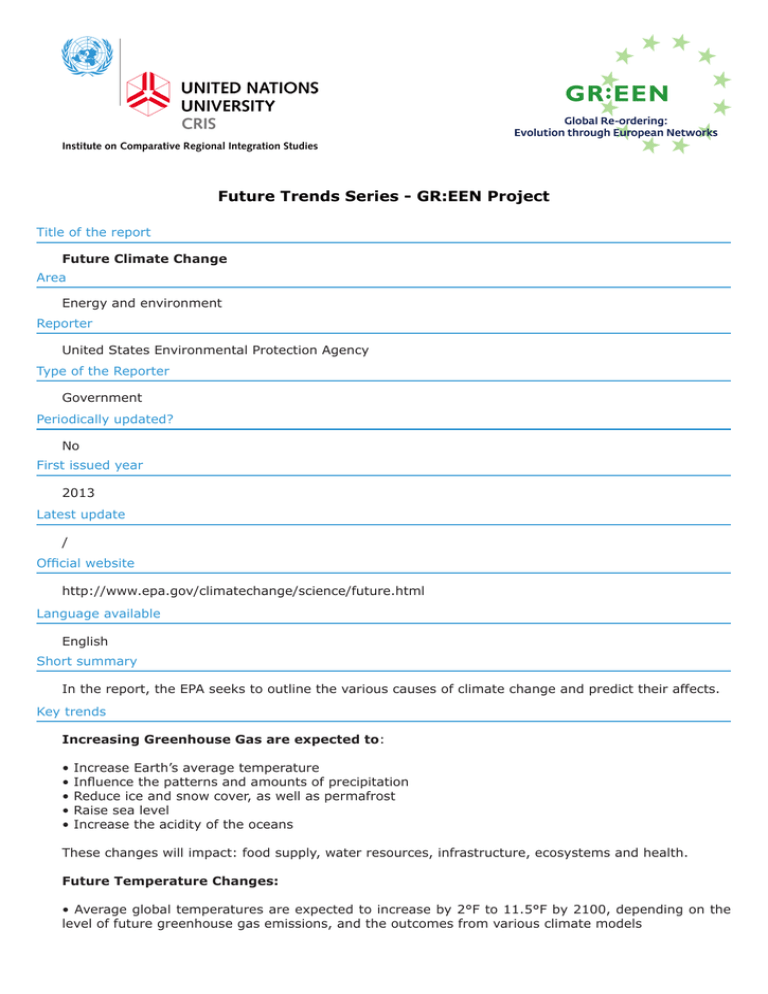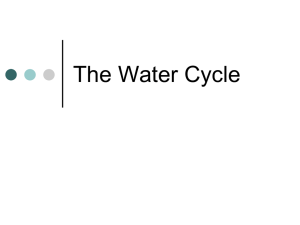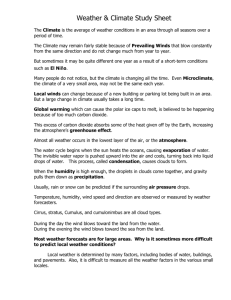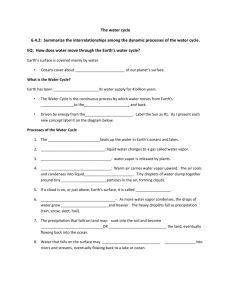Future Trends Series - GR:EEN Project
advertisement

Future Trends Series - GR:EEN Project Title of the report Future Climate Change Area Energy and environment Reporter United States Environmental Protection Agency Type of the Reporter Government Periodically updated? No First issued year 2013 Latest update / Official website http://www.epa.gov/climatechange/science/future.html Language available English Short summary In the report, the EPA seeks to outline the various causes of climate change and predict their affects. Key trends Increasing Greenhouse Gas are expected to: • • • • • Increase Earth’s average temperature Influence the patterns and amounts of precipitation Reduce ice and snow cover, as well as permafrost Raise sea level Increase the acidity of the oceans These changes will impact: food supply, water resources, infrastructure, ecosystems and health. Future Temperature Changes: • Average global temperatures are expected to increase by 2°F to 11.5°F by 2100, depending on the level of future greenhouse gas emissions, and the outcomes from various climate models • By 2100, global average temperature is expected to warm at least twice as much as it has during the last 100 years • Ground-level air temperatures are expected to continue to warm more rapidly over land than oceans • Some parts of the world are projected to see larger temperature increases than the global average Future Precipitation and Storm Events: • Global average annual precipitation through the end of the century is expected to increase, although changes in the amount and intensity of precipitation will vary by region • The intensity of precipitation events will likely increase on average. This will be particularly pronounced in tropical and high-altitude regions, which are also expected to experience overall increases in precipitation • The strength of the winds associated with tropical storms is likely to increase. The amount of precipitation falling in tropical storms is also likely to increase • Annual average precipitation is projected to increase in some areas and decrease in others Future Ice, Snowpack, and Permafrost: • For every 2°F of warming, models project about a 15 per cent decrease in the extent of annually averaged sea ice and a 25 per cent decrease in September Arctic sea ice • The coastal sections of the Greenland and Antarctic ice sheets are expected to continue to melt or slide into the ocean. If the rate of this ice melting increases in the 21st century, the ice sheets could add significantly to global sea level rise • Glaciers are expected to continue to decrease in size. The rate of melting is expected to continue to increase, which will contribute to sea level rise Future Sea Level Change: • Since 1870, global sea level has risen by about 8 inches. Estimates of future sea level rise vary for different regions, but global sea level for the next century is expected to rise at a greater rate than during the past 50 years Future Ocean Acidification • The pH level of the oceans has decreased by approximately 0.1 pH units since pre-industrial times, which is equivalent to a 25 per cent increase in acidity. The pH level of the oceans is projected to decrease even more by the end of the century as CO2 concentrations are expected to increase for the foreseeable future • As ocean acidification increases, the availability of calcium carbonate will decline. Calcium carbonate is a key building block for the shells and skeletons of many marine organisms. If atmospheric CO2 concentrations double, coral calcification rates are projected to decline by more than 30 per cent. If CO2 concentrations continue to rise at their current rate, corals could become rare on tropical and subtropical reefs by 2050 Suggestions / Methodology Research from secondary sources Reference to other trends reports? If yes, which reports? /






